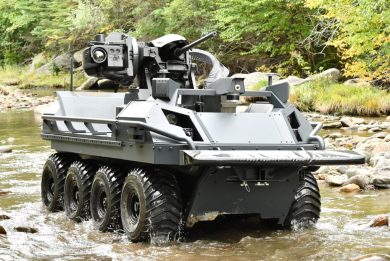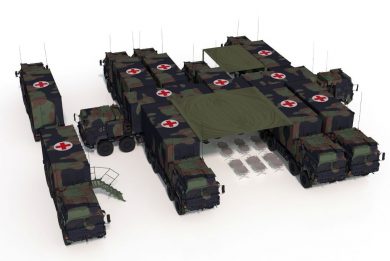► Rheinmetall – leading supplier of soldier systems and expert partner for network-enabled operations
10 September 2019 – The increasing digitalization of the modern battlefield poses challenges for the armed forces as well as offering opportunities. Reliable networking of systems and actors at multiple command echelons is very important given the decisive impact of information, command, and fire superiority. Turning its attention first and foremost to requirements at the mobile tactical level, Rheinmetall is creating solution concepts for the networked battlefield of the future. In this way, the Düsseldorf-based Group brings its partners directly into the “system of systems” loop.
At DSEI 2019, Rheinmetall is emphasizing its role as a leading supplier of advanced soldier systems. On show are the Canadian Argus system and its even more advanced successor, the Argus New Generation. The Group also makes the Future Soldier – Expanded System (IdZ-ES) used by the German Army, including the advanced Gladius 2.0 version.
All of these systems bring individual infantry soldiers, combat vehicles and unmanned systems into the tactical sensor-to-shooter network. Higher echelon command elements can also be included. The common operational picture forms the basis for faster, better-informed decision-making at all levels, a key factor in gaining and maintaining the initiative.
Argus – a highly adaptable technology and unparalleled situational awareness
Rheinmetall Argus soldier system is network-agnostic, resulting in increased uptime and the ability to integrate with any modern military radio. Specifically, its ability to connect to LTE networks allows for a much larger communication radius: LTE service is available all over the world and lets users exchange information over an extremely broad range, overcoming the strict geographical limitations of traditional radio.
Because Argus can also be used on any Android device, this technology is essentially universal: clients are no longer limited to TUIs to get the job done. It also creates the opportunity for easy integration in other sectors, such as security.
For the time being, Argus’ main focus is to provide platoon-level soldiers with the most effective tool possible for receiving mission-critical operational information. However, its forward-looking open architecture framework means that it will be able to run new applications in future; current add-ons include laser rangefinders, shot detectors, GPS, UGVs, UAVs, counter-UAV systems, etc.
When it comes to unmanned ground vehicles (UGV), Argus can easily indicate route planning or waypoint identification. It can also task the UGV to convert to follow-me or convoy mode. Moreover, its access to live video feeds from integrated cameras ensures enhanced visualization on the ground.
When time is of the essence and precision can save lives, the Argus soldier system is the key to streamlined decision-making and crystal-clear situational awareness. Argus’ ability to paint a real-time picture of friendly and enemy positions, obstacles, and essential coordinates can help advance operations, diminish loss of life, and expedite the decision-making process like never before.
This ultra-portable technology allows for tactical information to be shared in real time. The live map display also pinpoints terrain obstacles and similar potential hazards. With all of this data disseminated via a common network and laid out clearly on the display, the entire chain of command can access the exact same information. At any point, this data can be updated as new information is acquired.
IdZ-ES
IdZ-ES is at the heart of moves to digitalize the German Army. This state-of-the-art soldier system gives infantry and mechanized infantry forces and their Boxer and Puma fighting vehicles a decisive battlefield edge in network-enabled operations.
Thanks to the Bundeswehr ordering an additional lot of IdZ-ES sets last summer, more than 3,500 members of all three components of the German armed forces will soon be equipped with one of the most advanced soldier systems currently in service.
The “System Panzergrenadier VJTF 2023” substantially enhances the fighting strength of the NATO Spearhead Very High Joint Readiness Task Force VJTF 2023. Rheinmetall is equipping the mechanized infantry companies of the VJTF 2023 with “TacNet”, its battle management system (BMS). In addition, an initial lot of ten platoon versions of the “Future Soldier – Expanded System” soldier system will be brought up to modern VJTF 2023 standard.
Modernizing the command and control capabilities of complete mechanized infantry companies and bringing the IdZ-ES up to VJTF 2023 standard involves modifying the hardware and software. Dispensing with the “electronic backbone” is one key innovation. Others include advanced new radio systems for dismounted troops and infantry fighting vehicles, which result in improved command capabilities as well as enabling secure transmission of large amounts of data. Improved communication between the Puma crew and the dismounted infantry section will result in a continuously updated, uniform common operational picture. This way, Rheinmetall gives mechanized infantry a command-and-control capability that extends from the company commander to the individual rifleman on the ground. At the same time, Rheinmetall views these measures as a template for further modernization and digitization of the Bundeswehr.
Gladius 2.0
Debuting in 2017, the Gladius 2.0 builds on Rheinmetall’s wealth of experience in soldier systems. Thanks to its open architecture and independence from specific end devices, e.g. radio systems, Gladius 2.0 features a high degree of scalability and flexibility. Extra components can be easily added on a plug and play basis. This means that the system can be adapted to meet the evolving needs of different customers. The Gladius 2.0 system demonstrator, for example, was initially configured in three different variants. The Basic variant is the standard version for infantry soldiers. It comes with a smartphone that serves as the command computer, enabling participation in network-enabled operations. The Advanced version encompasses an expanded array of capabilities for military leaders, including a second radio for communication with higher-echelon command elements. In particular, Gladius 2.0 is characterized by high scalability and flexibility. This means that other components can be easily connected to all variants on a plug-and-play basis. Augmenting the portfolio is the Light version, an extremely low-weight variant designed for special operators.
TacNet – Rheinmetall’s Tactical Management System
TacNet is Rheinmetall’s Tactical Management System (TMS). It is designed to meet the requirements of high-mobility operations at the tactical level, essentially serving as a command and weapon engagement system. TacNet Soldier is specifically tailored for use in soldier systems, augmented by TacNet Vehicle for the accompanying combat vehicles.
In revolutionary fashion, TacNet Vehicle welds two different software systems into a single product family. The cross-sectional display and control device feeds directly into TacNet. This expands the operational spectrum of the software to all touchscreen-operated systems. Other means of entering data, e.g. via control handles, are also possible.
As an integrative system, TacNet networks platforms, sensors and effectors. It is compatible with other command & control systems and interoperable thanks to the use of internationally recognized standards. Due to its array of role-based functions, TacNet is scalable. Moreover, it can be expanded with the help of apps, including those produced by third parties.
At DSEI 2019, Rheinmetall’s Lance medium-calibre turret will be networked with the Gladius soldier system. This is done via the cutting-edge TacNet command and control system.
A leading maker of soldier systems, pointing the way in Europe’s GOSSRA project
Overcoming multiple competitors, Rheinmetall has won the first request for proposals for preliminary studies relating to European Union defence research financed by the EU’s European Defence Union. Under a project known as “Generic Open Soldier Systems Reference Architecture”, or GOSSRA, the European Commission has put the globe-spanning tech group in charge of a consortium consisting of partners from nine different EU member states.
Under the GOSSRA project, studies will be conducted into developing an open reference architecture as the basis of EU-wide standardized soldier systems. This includes electronics, voice and data communication, software solutions, man-machine interfaces, sensors and effectors.



